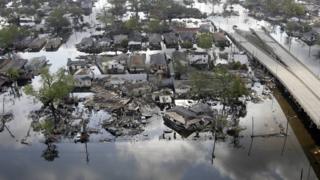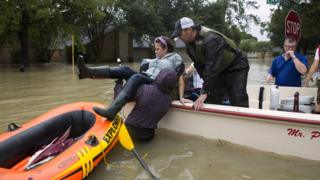 Image copyright NASA Image caption Hurricane Florence gains strength in the Atlantic Ocean as it moves west, seen from the International Space Station on Monday
Image copyright NASA Image caption Hurricane Florence gains strength in the Atlantic Ocean as it moves west, seen from the International Space Station on Monday
“Storm of a lifetime” hurricane Florence is predicted to bring deadly disaster to large parts of the eastern US coast when it makes landfall on Thursday.
But as millions are under order to flee, some are being told they have to stay put.
On Monday, South Carolina officials announced they would not remove inmates from at least two prisons inside mandatory evacuation zones.
“In the past, it’s been safer to leave them there,” a spokesman for the South Carolina Department of Corrections said.
One of those facilities is no longer in those zones but remains in Florence’s path.
 Image copyright AFP Image caption Flooding in New Orleans after hurricane Katrina in 2005
Image copyright AFP Image caption Flooding in New Orleans after hurricane Katrina in 2005
New Orleans was particularly badly hit but prisoners locked in cells in the city’s jail were not moved to another facility. A third of the inmates had been awaiting trial – not convicted of any crime.
Power cuts and broken generators caused ventilation and lights to fail and electric cell doors to remain shut. One guard reported that officials had fled as the waters had risen.
Prisoners were abandoned in cells without food or water for days as [toxic] floodwaters rose towards the ceiling, according to reports by the ACLU and Human Rights Watch based on more than 1000 eyewitness accounts.
Prisoners of Katrina
Orleans Parish Prison was eventually evacuated four days after the storm hit. Some inmates say they saw dead bodies and Human Rights Watch claimed that 517 prisoners had gone missing.
In 2006, Sheriff Marlin Gusman maintained no prisoners had died and none had escaped. Later, it emerged that arrest warrants had been issued for 14 escaped inmates.
Why are prisons not evacuated?
South Carolina has not evacuated prisons in response to hurricanes since 1999, according to local media.
 Image copyright Getty Images Image caption Houston residents are rescued after flooding caused by heavy rain during hurricane Harvey in 2017
Image copyright Getty Images Image caption Houston residents are rescued after flooding caused by heavy rain during hurricane Harvey in 2017
In Texas, four county jails were evacuated before hurricane Harvey made landfall last year. Built to withstand the most severe hurricanes, they were evacuated as a precaution and sustained some structural damage.
But in Houston, which was severely flooded, inmates left in prisons and jails reported minimal drinking water and food and poor access to medicine, as well as stifling heat.
In 1992, hurricane Andrew slammed Florida, causing huge damage to one prison in Miami, after which about 4,000 prisoners were moved out.
By Georgina Rannard, UGC and social news






